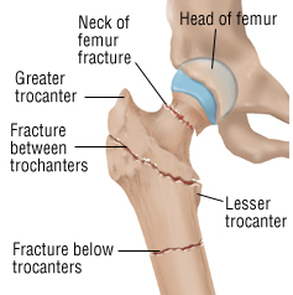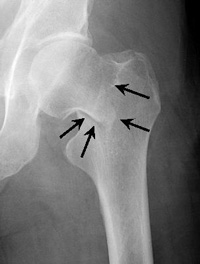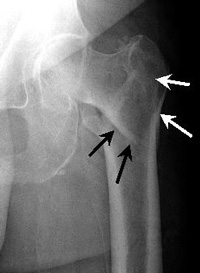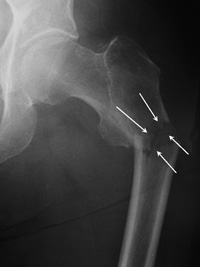A subset of fractures that happen in an individual's hip region are called proximal femur fractures, otherwise known as hip fractures. This injury can occur in both low-impact and high-impact trauma. Elderly patients and those with osteoporosis can suffer from this injury during low-impact trauma while younger patients may experience this type of wound during a car crash or sport-related activity. In any case, it is important to take proper care of hip fractures as not doing so can cause serious complications later on.

Classification of Proximal Femur Fracture
There are primarily three types of hip fractures. They are classified by where the fracture occurs on the upper femur.
1. Intracapsular Fracture

This classification of a proximal femur fracture occurs when the injury is generally contained in the hip capsule located at the neck and head of the femur. The capsule is responsible for lubricating the joint and is made up of soft-tissue which surrounds the area.
2. Intertrochanteric Fracture

A hip fracture is classified as an intertrochanteric fracture if it occurs between the neck of the femur and the less trochanter, a bony prominence. The injury usually occurs in the area between the lesser trochanter and the greater trochanter, the bony bump you can feel on the side of your hip. This is the area of your hip where major muscles are attached.
3. Subtrochanteric Fracture

This injury occurs somewhere between the lesser trochanter. The fracture occurs in spot about 2 ½ inches below it.
Why Does It Happen?
Hip fractures happen most often in patients 65 or older. The most common cause is a fall. As we age, our bones lose strength and are more susceptible to injury and breaks. In young adults and children, hip fractures are usually caused by a sports injury or vehicle accident.
Some people have a greater risk of a proximal femur fracture:
- Being a woman
- Calcium or vitamin D deficiencies
- Family history of members who suffered fractures as they got older
- Smoking
- Lack of exercise
- Certain medications that weaken bones
- Medical conditions which cause problems with movement and balance
How Will You Know If You Have Proximal Femur Fracture?
Look out for the following signs if you think you might be suffering from a hip fracture:
- Severe pain in your groin area or hip
- Inability to move after a fall
- Leg is shorter on side of hip injured
- Swelling and stiffness in the hip area
- Leg turning outward where hip injury is located
- Pain when putting weight on side of hip injury
Diagnosis
If you have these symptoms and your hip appears to be in an awkward position, you doctor will order an x-ray to determine if you are suffering a hip fracture and where it is located. If the x-ray does not reveal a fracture but the pain is present, you may have a bone scan or MRI to look for a hairline fracture.
How Is Proximal Femur Fracture Treated?
Treatment typically consists of a combination of surgery, medications and rehabilitation.
1. Surgery
There are several different types of surgery for hip fractures and which one you have depends on where the injury occurred. It's important to get surgery as soon as possible so other medical problems do not arise. It will also typically reduce your pain, chances of complications and the length of your hospital stay.
- "Hip pinning" or internal fixation is a type of hip repair surgery used if your bones cannot be properly lined up. It involves the use of metal rods, screws and plates. The placement of these enable the bones to stay together during the healing process.
- Sometimes, hip replacement surgery is required. Some or the entire joint is replaced with artificial parts. When only the upper part of the thighbone is replaced, it's considered a partial hip replacement. When the hip socket must be replaced as well, it's called a total hip replacement. This occurs when the fractured hip bones cannot line up correctly.
2. Rehabilitation
The day after your surgery, your physical therapist will get you out of your bed. Therapy will start right away with exercises concentrating on motion and strength. Depending on the severity of your injury and the type of surgery you had, you may have to have someone stay in your home with you while you recover. If this is not feasible, you might be transferred to an extended care facility.
No matter where you go after your surgery, you will also work with an occupational therapist. The therapist will teach techniques that will help you cope with your recovery when performing normal tasks like dressing, bathing, using the restroom and cooking. This is when it's determined if you will need the assistance of a walker or wheelchair until you reach full recovery.
3. Medication
One in five patients who suffer from a proximal femur fracture will experience another one within two years or less. There is a type of medication classified as bisphosphonates that can help reduce your chances of suffering another hip fracture.
Patients who have kidney problems should not take bisphosphonates. Side effects include acid reflux, GERD and inflammation of the esophagus. The medicine can be taken orally or intravenously. Sometimes, though rare, with long-use you may experience vision problems or pain and swelling in your jaw. Very rarely, an atypical hip fracture may occur.
Can It Be Prevented?
Your chances of a proximal femur fracture or developing osteoporosis are greatly reduced if you start making healthy lifestyles from a young age. However, no matter how old you are, you can improve your overall health and reduce your risk of a fall by making these changes or modifications in your life:
- Incorporate into your routine weight-bearing exercises designed to strengthen bones and increase your ability to balance. We lose bone density and balance as we age, so by improving in these areas you will lengthen your peak bone density time period.
- Make sure you are getting enough vitamin D and calcium. Both men and women 50 years old or older should have 600 international units of vitamin D and 1,200 milligrams of calcium each day.
- Don't smoke and limit your alcohol intake as they can reduce your bone density prematurely. Also, when you drink too much you can fall because your balance is affected.
- Safe proof your house against fall hazards. Get rid of or rearrange furniture and floor rugs that are trip hazards. Make sure your home is well-lit so you don't trip. Keep electrical cords tucked away or pushed against the wall to lessen your chances of falling over them.
